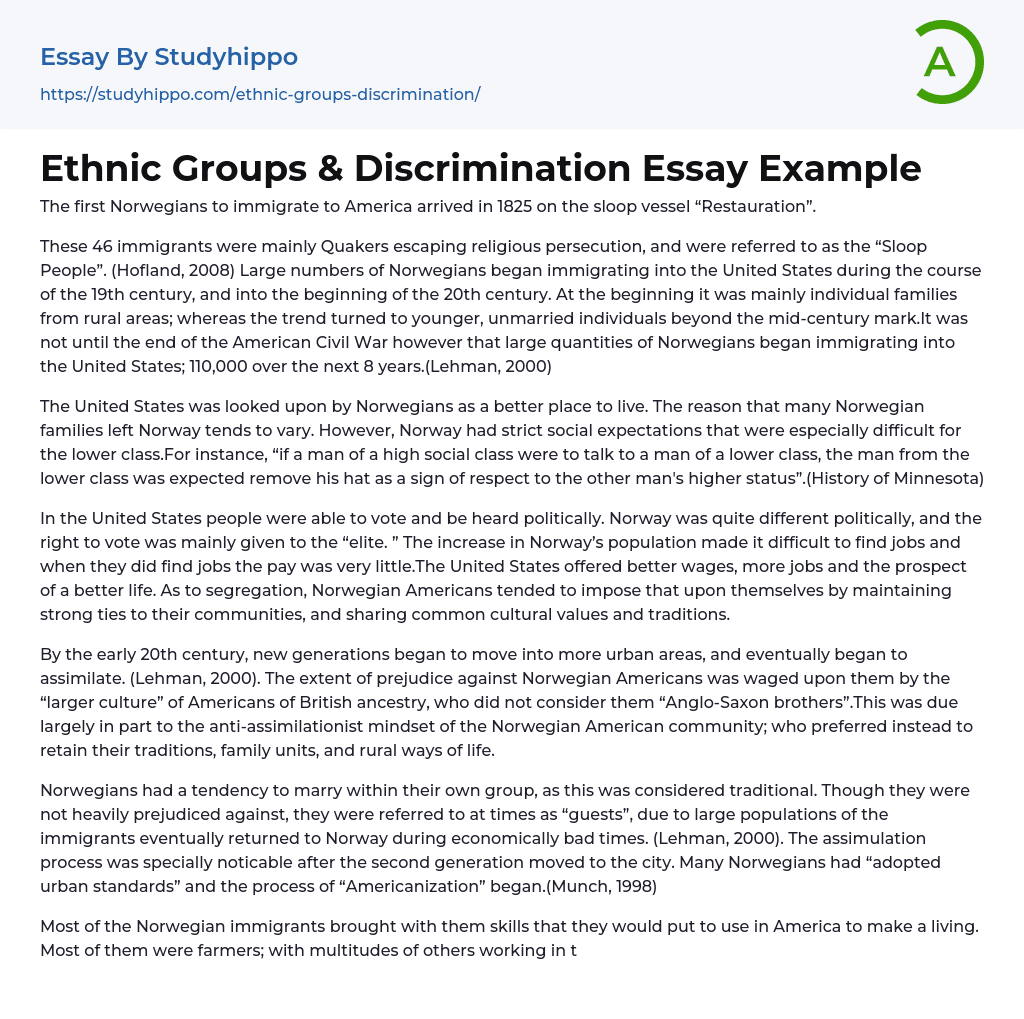The first Norwegians to immigrate to America arrived in 1825 on the sloop vessel “Restauration”.
These 46 immigrants were mainly Quakers escaping religious persecution, and were referred to as the “Sloop People”. (Hofland, 2008) Large numbers of Norwegians began immigrating into the United States during the course of the 19th century, and into the beginning of the 20th century. At the beginning it was mainly individual families from rural areas; whereas the trend turned to younger, unmarried individuals beyond the mid-century mark.It was not until the end of the American Civil War however that large quantities of Norwegians began immigrating into the United States; 110,000 over the next 8 years.(Lehman, 2000)
The United States was looked upon by Norwegians as a better place to live. The reason that many Norwegian families left N
...orway tends to vary. However, Norway had strict social expectations that were especially difficult for the lower class.For instance, “if a man of a high social class were to talk to a man of a lower class, the man from the lower class was expected remove his hat as a sign of respect to the other man's higher status”.(History of Minnesota)
In the United States people were able to vote and be heard politically. Norway was quite different politically, and the right to vote was mainly given to the “elite. ” The increase in Norway’s population made it difficult to find jobs and when they did find jobs the pay was very little.The United States offered better wages, more jobs and the prospect of a better life. As to segregation, Norwegian Americans tended to impose that upon themselves by maintaining strong ties to their communities, an
sharing common cultural values and traditions.
By the early 20th century, new generations began to move into more urban areas, and eventually began to assimilate. (Lehman, 2000). The extent of prejudice against Norwegian Americans was waged upon them by the “larger culture” of Americans of British ancestry, who did not consider them “Anglo-Saxon brothers”.This was due largely in part to the anti-assimilationist mindset of the Norwegian American community; who preferred instead to retain their traditions, family units, and rural ways of life.
Norwegians had a tendency to marry within their own group, as this was considered traditional. Though they were not heavily prejudiced against, they were referred to at times as “guests”, due to large populations of the immigrants eventually returned to Norway during economically bad times. (Lehman, 2000). The assimulation process was specially noticable after the second generation moved to the city. Many Norwegians had “adopted urban standards” and the process of “Americanization” began.(Munch, 1998)
Most of the Norwegian immigrants brought with them skills that they would put to use in America to make a living. Most of them were farmers; with multitudes of others working in timber and lumber industries, fishing and shipping, and construction. Norwegian women mainly worked as domestic servants. Unlike many of the other groups within our history the women were paid quite well.This also aided in Norwegian women learning the American language.(Lehman, 2000).
I have come to the conclusion that Norwegians did not face as much persecution and discrimination as other subordiate groups. I believe this is due to the skills that they brought with them, and that they did not depend on others. They bought their own land, and lived off of
that land; by farming, and things of that nature. They practiced predomiantly the christian religion, which in turn, made them blend more with the religious majority of Americans.
I identify more with the American culture than any. I have lived in America all of my life and have very little knowledge of my heritage. I believe that I would love to know more about my family history and I will certainly take the time to better understand my family tree. During the course of this assignment I phoned my grandmother and was able to learn interesting information regarding my family’s personal experience during their immigration.
My Great, great grandfather was excited to live in America and he did not face persecution and prejudice.He bought land and at first lived in a hillside until he could afford to build a home. He and my Great, great grandmother had ten children and they were farmers, who worked very hard. I can honestly say that I am completely Americanized, as I could not imagine living in a hillside.
I have much admiration for the advantages that they gave me by immigrating to the United States.
Works Cited
- "History of Minnesota. " Norwegian Immigration. http://www.mnsu. edu/emuseum/history/mnstatehistory/norwegian_migration. tml (accessed June 07, 2008).
- Hofland, Neil A. "RootsWeb." Ancestry. com. 2008. http://archiver. rootsweb. ancestry.com/th/read/NORWAY/1999-05/0925640459 (accessed June 7, 2008).
- Lehman, Jeffrey. "Energy of a Nation:Immigration Resources. " The advocates for human rights. 2000. http://www.energyofanation. org/3f9c3958-cf6f-43ed-a9bf-05b8ad118870. html? NodeId= (accessed June 7, 2008).
- Munch, Peter A."Segregation and Assimilation. " In Segregation and Assimilation, by Peter Munch, 126. 1998.
- Migration essays
- Human Migration essays
- Illegal Immigration essays
- Immigrants essays
- Refugee essays
- Ageism essays
- Cultural Diversity essays
- Discrimination essays
- Diversity essays
- Gender Discrimination essays
- Multiculturalism essays
- Oppression essays
- Peer Pressure essays
- Racial Profiling essays
- Sexism essays
- Abortion essays
- Abuse essays
- Animal Rights essays
- Animal Testing essays
- Assault essays
- Bullying essays
- Controversial Issue essays
- Crash essays
- Cyber Bullying essays
- Feminism essays
- Human Rights essays
- Immigration essays
- Inequality essays
- Poverty essays
- Prejudice essays
- Racism essays
- Torture essays
- Violence essays
- Anthropology essays
- Audience essays
- Charity essays
- Cultural Competence essays
- Emile Durkheim essays
- Gender Roles essays
- Generation essays
- Globalization essays
- Interpersonal Relationship essays
- People essays
- Race essays
- Social Change essays
- Social Class essays
- Social Movement essays
- Social Science essays
- Social Status essays
- Social Stratification essays




